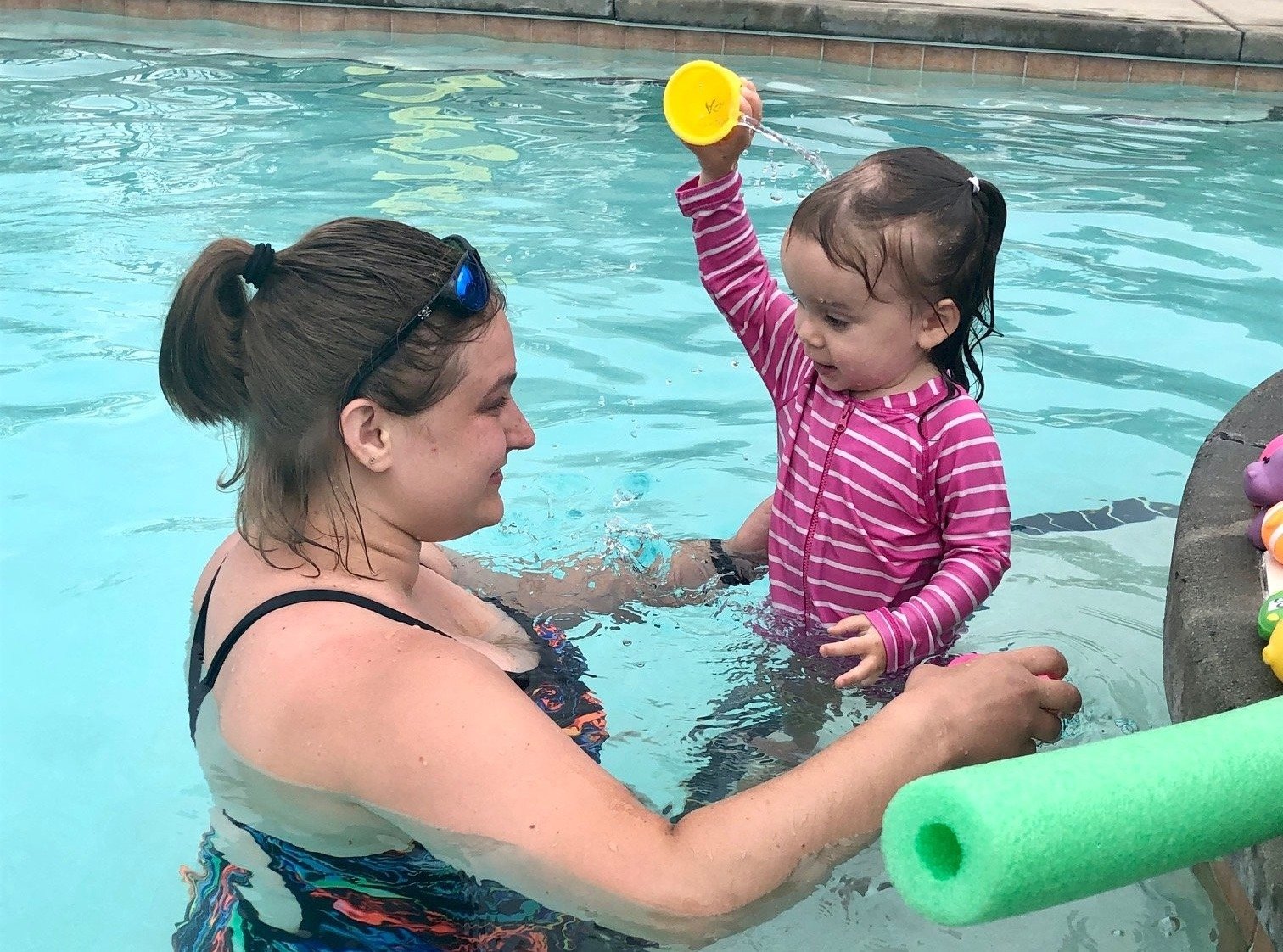Infant/Toddler Swim Lessons

We love teaching babies and toddlers to swim! These classes are for infant (6 months and older who have good head control) through 3 years old. Our instructors are trained in gentle methods to allow them to connect with students, build trust, and teach at a challenging but appropriate pace for each child. We believe skills are best learned and retained when a child feels safe, so our instructors are trained to tune into body language and cues from your child to keep lessons progressing and fun.
Happy Baby Lessons:
In these lessons we will sing, play, and use other age-appropriate techniques and pacing to introduce your child to water skills, safety sequences, and build their comfort and enjoyment in the water. These 30-minute lessons belong to you and your child! Parents can choose to be in or out of the water based on their child's comfort level. If you prefer to do a semi-private lesson with another family that is fine too - infants and toddlers love to learn from each other!
Happy Baby Safety Lessons:
These lessons are private lessons specifically designed to move infants and toddlers toward confidence and safety in the water. They will focus on developing breath-holding skills, back floating, and safety sequences.
Since these lessons require special training for the instructors, and we are very intentional in making a good match for each instructor and student, there will be limited slots available for these lessons. Each student who is new to BDA must take 3 Happy Baby Private Lessons prior to beginning the Happy Baby Safety Lessons - this is to allow time to build a trust relationship between student and instructor before beginning more advanced skills.
Also, please note that in order for safety skills to be learned and retained, consistency is key. Getting your baby in the water to swim and practice several times a week will be the difference between retaining and losing their new skills.
We have two options for Safety Lessons:
Option 1: Swim Baby - These are 30-minute weekly lessons with the instructor's time divided between one-on-one time with the student and "homework" time with the parent. The instructor will spend the first 15-20 minutes with the student, and the remaining time demonstrating and explaining to the parent what skills to practice during the week before the next lesson. This allows parents to be actively involved in their child's progress and help with learning retention! These lessons are a minimum of once a week with a suggested duration of at least 6 weeks, and parents are expected to practice with their infant or toddler at least once per week between lessons.
Option 2: Swim Baby Intensive - These are 15-minute one-on-one lessons with your infant or toddler that meet 2-3 times a week for 4-6 consecutive weeks. Parents will be expected to get in during the last few lessons so the instructor can explain and demonstrate to the parents the skills to work on when your scheduled lessons are complete. These lessons are harder to schedule because the pool schedule, instructor schedule, and student schedule may not always line up 2-3 times a week. But this option is available when we can!
Infant/Toddler Swim Lesson FAQs
What will my child learn during lessons?
What your child will learn depends on their age and developmental readiness. Our first goal for each student, beyond learning to enjoy the water, is to learn the safety skill of rolling onto their back to float, rest, and breathe. Once that is mastered, we will work towards the safety sequence of jumping in, surfacing, rolling to the back float to breathe, swimming back to the wall, grabbing onto the wall, and exiting the pool. Each song, rhyme, and activity will be working toward one of those goals and building into a bigger picture of more fun and safety in the pool.
Will my child be put under the water?
Learning to be safe in the water includes going under water at times; however, we ease into this skill gradually and as appropriate for the child’s age and ability level. We believe more is retained long-term when the student is a willing participant! We will work on breath control before adding submersions into the lesson and will limit submersions to three times per lesson until breath control is mastered/consistent.
What if my child starts crying during a lesson?
Crying happens – water can feel new, weird, or scary, as can getting to know a new person. If your child starts crying, we will evaluate their body language and facial expressions to see if we should continue with a skill or stop. When necessary, we will switch to another skill, change up the activities or add in a game/song to help get back to a productive and fun lesson. This is part of the beauty of our instructional model – it is child centered. If we feel a child is clearly terrified or possibly not feeling well, then we will not force a skill. And if a child is truly inconsolable, we will talk with the parent/guardian present to determine the best course of action for that day.
Will you use floatation devices during lessons?
We try to limit the use of floatation at this age. Sometimes though, we use noodles to help develop independence from the instructor/parent and floating mats to get them comfortable being on their stomach and back without being held. With older toddlers we may, on occasion, also use a learn-to-swim back float (we call them turtle shells) to give them a confidence boost as they navigate a new skill. But at this age, less floatation is better so that children don’t become dependent on using a device in the water. That said, we also understand sometimes parents of multiples need to occasionally use flotation in order to safely bring everyone to the pool… so it is important children learn and understand the difference of being in the pool with flotation versus no flotation.
Can/should my child wear goggles during lessons?
For infants and toddlers, we prefer to do lessons without goggles. For safety reasons, we want them to master their skills without depending on goggles!
Should we come early to warm-up before lessons?
It is fine to come early to observe, but please do not come to play in the pool before the lesson. Depending on how long they have been at the pool it can leave them tired, cold and cranky and therefore unwilling to participate in their lessons. Plus, if the child is in the middle of playing with you or their friends it can be difficult to transition them to the lesson. Practice before play is always the best policy whether it is for a lesson or just to come to the pool and practice/play between lessons.
How can I help prepare my child for their lessons?
- If your child is fearful of getting their face wet, practice in the bath or shower! We like these cups as you can sprinkle or dump water on their heads. Fun squirt toys and bath mitts like these are great, too!
- If your toddler loves books, Leo Can Swim by Anna McQuinn is a fun book to check out if you are attending swim lessons for the first time.
- Clipping your child's nails is also helpful - the instructors appreciate it.
- Use common sense with when and what you feed them before the lesson - you do not need to keep them from eating before a lesson, but no one feels good exercising on a full stomach of heavy food!
- If your child is not full potty trained, please make sure your child is double diapered; a single use disposable swim diaper with a reusable diaper on top.
- If your child is potty trained, a trip to the potty before the lesson is always a good idea!
Last Updated 2/13/22
